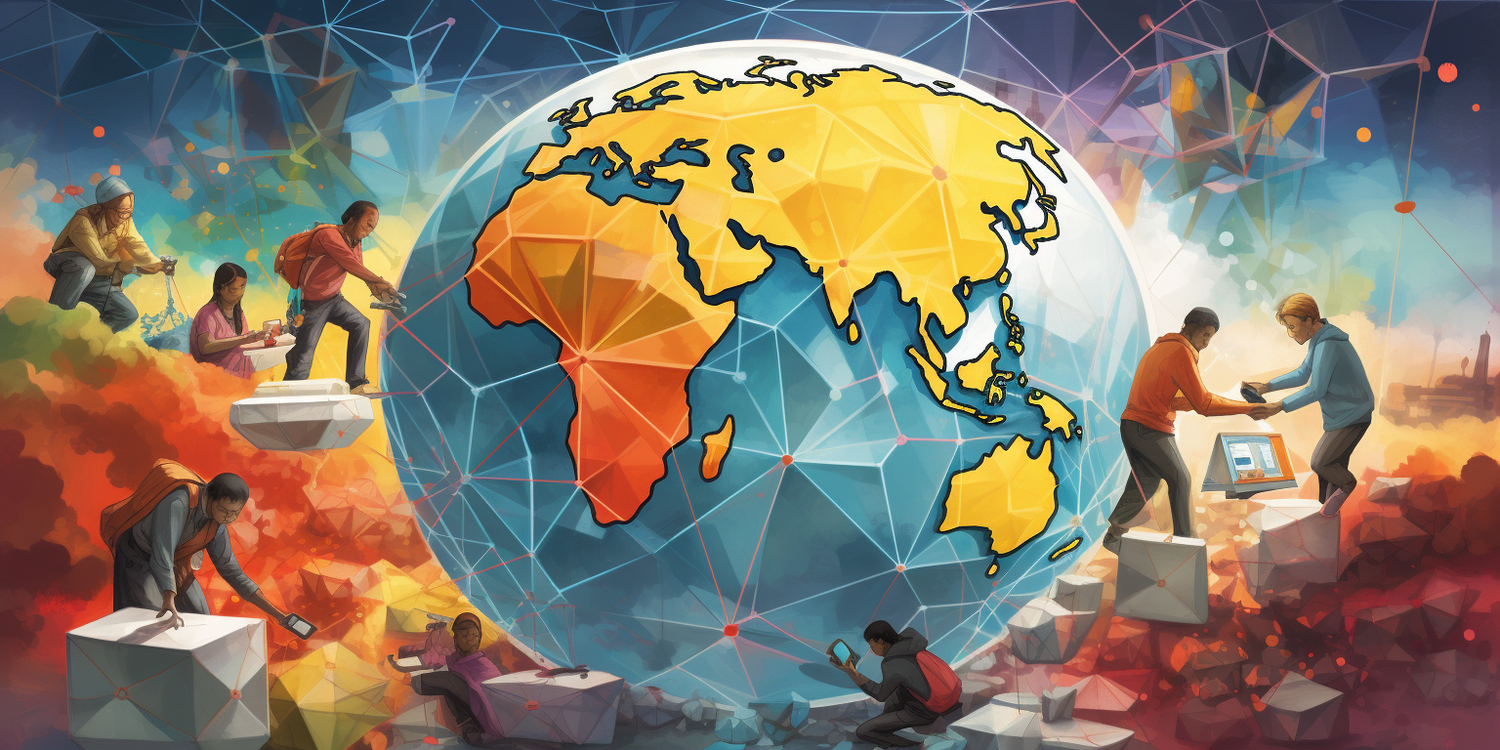Why Web3 is still thriving in Asia — and why cloud is central to that success

Matt A.V. Chaban
Senior Editor, Transform
If crypto is still shining anywhere, it is in the Asia-Pacific region, where many tech businesses have long prospered precisely because of the need to be decentralized. Here's how cloud is playing a role in this ongoing boom.
For anyone familiar with the technology scene in the Asia-Pacific region, it should come as no surprise it has become a hotbed for Web3 technologies. In many ways, the region is an ideal bedrock for blockchain startups and companies to develop or seed their latest innovations.
A wide range of digital financial services, from digibanks to payment gateways and buy-now-pay-later platforms, have flourished in emerging markets in Southeast Asia by filling the gap from historically limited access to formal banking services. Now, the region’s players are prioritizing achieving profitable growth despite challenging macroeconomic headwinds. Asia is also home to a diverse and expanding population of young digital natives, a thriving creator economy, and millions of mobile gamers open to embracing new technologies, making it one of the best places in the world to forge the next generation of the internet.
And there are plenty of exciting Web3 leaders that deserve attention, whether it’s Nansen empowering Web3 investors with high-quality blockchain analytics and insights, Web3Auth helping users take ownership of their digital identities with non-custodial authentication methods, or Sky Mavis giving its gaming communities digital asset rights within the games they play.
Last month, Token2049, a premier global crypto event held annually in Singapore, brought founders, executives, developers, investors, and other Web3 enthusiasts together to share the latest global developments happening across the industry. To that end, it felt like a fitting time to shine some light on some of the region’s most noteworthy innovators and underscore some of the ways the cloud and Web3 are coming together to reshape the future of the web — and the world.
Bolstering the blockchain with enterprise-grade infrastructure
The evolution of Web3 technologies promises to usher in a new era of transformation and value creation, with a heavy emphasis on decentralization, data ownership, and enhanced privacy and security.
Still, these new technologies come with certain limitations around scalability, interoperability, usability, and security that can hinder widespread adoption. Decentralized networks come with inherent constraints that can slow processing times and increase fees when the volume of users or transactions surge.

More and more, cloud platforms are taking on an important role in Web3 development, providing enterprise-grade cloud infrastructure and services that help companies and developers to scale their businesses and support the growth of their networks. For instance, Sky Mavis, the creator of popular game title Axie Infinity, has opted to build on cloud infrastructure to distribute its community-built games scalably while ensuring a strong uptime for users, regardless of where they are in the world or what device they are using.
Another example is Zilliqa Group’s recent announcement at Token2049 to reinforce the scalability, resilience, and data availability of its blockchain, with help from Google Cloud. The high-throughput public blockchain platform Zilliqa has always been an innovation leader at the forefront of seeking solutions to address blockchain limitations. It launched the first public blockchain sharding architecture to increase processing capabilities and its own peer-reviewed programming language specifically designed for smart contract safety.
Google Cloud will join Zilliqa’s existing set of 28 staked seed node (SSN) operators, helping to validate transactions across the network. Zilliqa will also be able to tap into Google Cloud’s open, secure, scalable, and energy-efficient infrastructure and services to ensure network scalability, the security of its nodes and applications, and make an on-chain data record available for public inspection and analysis.
Empowering Web3 developers with operational excellence
Beyond accessing the power of cloud infrastructure, the cloud offers many other opportunities to help developers speed up the delivery of software and data. Blockchains act as a sort of decentralized database, permanently storing and encrypting transaction data. Nodes are an essential element of Web3 technology, acting as the governing infrastructure that helps to maintain the integrity and security of the transaction data across a blockchain’s network.
However, deploying and self-managing nodes is costly, time-consuming, and complex, creating a host of challenges for Web3 companies building blockchain-based platforms. Cloud services, combined with unique solutions designed for Web3 developers, can accelerate development, simplify node deployment, and help them address other critical requirements around data governance, security, and sustainability.
Beyond infrastructure, the cloud offers many opportunities to help Web3 developers speed up the delivery of software and data.
Polygon Labs, for instance, has joined forces with Google Cloud to make it easier for developers to build, launch, and grow Web3 products and decentralized apps (dApps) on top of the core Polygon protocols. One of the first steps will be to bring Blockchain Node Engine, a fully managed node hosting service, to the Polygon ecosystem, helping to reduce many of the time-intensive and costly overheads that often slow developers down. In addition, Google Cloud will serve as a validator on the Polygon Proof of Stake (PoS) network, contributing to its security, governance, and decentralization.
A move toward cloud adoption for Web3 developers also opens up new opportunities to tap into emerging AI capabilities and cloud-based services to free up developer time for work that creates value and improves customer experience. Blockchain data analytics platform, Nansen, has turned to cloud technologies, such as serverless streaming analytics, automated workflow orchestration, data filtering, and messaging delivery, to reduce laborious engineering tasks and make optimal use of its technical talent. Adopting an AI platform has made it possible for data scientists to bring new ML-powered features, such as a price estimator for NFTs, to life in a matter of weeks instead of spending months building pipelines from scratch.
Similarly, Southeast Asian Web3 games software company Ethlas was able to quickly launch enterprise-grade generative AI applications using Google Cloud’s AI-optimized infrastructure and end-to-end platform for tuning and deploying AI models. As a result, Ethlas has been able to improve the player experience with hyper-personalized generative weapons that allow their game artists to generate gaming assets on the fly. In the next couple of weeks, due to popular demand, Ethlas' Battle Showdown will also open its weapon AI system to gamers to allow them to customise their in-game characters using gen AI.
Powering the next wave of innovation with deep tech partnerships
The evolution of Web3 bears more than a passing resemblance to the rise of open source, with both spaces embracing many similar traits — transparency, explicit trust, and collaboration toward a shared goal. Similar to the community spirit that drove the creation of numerous open source innovations, the new Web3 paradigm also fosters a culture of collaboration and partnership to achieve its goals of decentralization, transparency, and security.
Google Cloud is working closely with leading Web3 players to help push innovations to the next level, such as teaming up with Orderly Network to develop off-chain infrastructure components to ensure more secure and accessible decentralized finance environments, or adding more in-demand blockchains to enhance the BigQuery public datasets program.


It is curious how a technology so rooted in being diffuse and distributed has at the same time forged many business and social partnerships across the Asia-Pacific region.
Another particularly noteworthy alliance, which was also announced at Token2049, are two community-backed initiatives to improve the Polkadot network — a developer-friendly blockchain ecosystem that facilitates the cross-chain transfers of any data or asset. Blockchain infrastructure firm OnFinality and Google Cloud are working together to empower developers to build, launch, and scale interconnected dApps with support from the Polkadot treasury.
These initiatives aim to address some of the biggest Web3 pain points, including excessive technical overhead and high costs associated with node infrastructure management and lack of public access to on-chain and cross-chain analytics. OnFinality and Google Cloud will work to develop a common infrastructure to help developers scale projects and applications built on Polkadot as well as building and maintaining a scalable common data platform that is accessible to data users both in and beyond the Polkadot ecosystem.
The next horizon of Web3 is transformational partnerships that aim to deliver new solutions that solve the toughest challenges facing blockchain technologies. Cloud providers can act as more than a transactional vendor and take an active stake in helping the Web3 ecosystem innovate more efficiently, securely, and flexibly.



